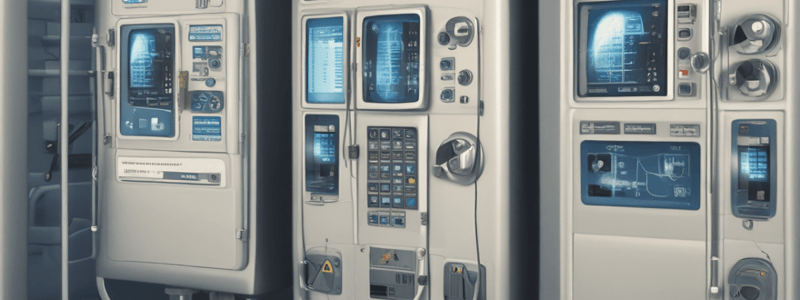Podcast
Questions and Answers
What was the response of the FDA to the issue of implanted infusion pumps in MRI scanners?
What was the response of the FDA to the issue of implanted infusion pumps in MRI scanners?
- Permanently banned the use of implantable infusion pumps
- Stopped the production of implantable infusion pumps
- Issued a special safety communication in 2017 (correct)
- Issued a special safety guideline in 2015
What can happen to an implantable infusion pump when exposed to an MRI scanner?
What can happen to an implantable infusion pump when exposed to an MRI scanner?
- It has no effect on the pump
- It can cause permanent device failure due to demagnetization of the pump magnet (correct)
- It can only decrease the rate of drug delivery
- It can only increase the rate of drug delivery
Where is the catheter tip typically placed in an implantable infusion pump?
Where is the catheter tip typically placed in an implantable infusion pump?
- Intravenously or intra-arterially
- Subcutaneously or intraperitoneally
- Intrathecally or epidurally
- All of the above (correct)
What type of drug is typically administered via implantable infusion pumps for spasticity?
What type of drug is typically administered via implantable infusion pumps for spasticity?
How long have implantable infusion pumps been used clinically?
How long have implantable infusion pumps been used clinically?
What is the mechanism of fluid propulsion in propellant-driven pumps?
What is the mechanism of fluid propulsion in propellant-driven pumps?
Which of the following companies does not manufacture implantable infusion pumps currently used worldwide?
Which of the following companies does not manufacture implantable infusion pumps currently used worldwide?
What is the purpose of the refilling port in an implantable infusion pump?
What is the purpose of the refilling port in an implantable infusion pump?
What is the primary function of the flurochlorocarbon propellant in intrathecal infusion pumps?
What is the primary function of the flurochlorocarbon propellant in intrathecal infusion pumps?
What is the common feature among all the pumps listed in the text?
What is the common feature among all the pumps listed in the text?
What is the potential risk of RF-heating during scanning?
What is the potential risk of RF-heating during scanning?
What is the unique limitation of Prometra pumps in an MR environment?
What is the unique limitation of Prometra pumps in an MR environment?
What is the primary function of the rollers on the rotating wheel in SynchroMed pumps?
What is the primary function of the rollers on the rotating wheel in SynchroMed pumps?
Why is palpation of the implanted SynchroMed pump necessary?
Why is palpation of the implanted SynchroMed pump necessary?
What may occur when a patient with a SynchroMed pump is placed in the scanner?
What may occur when a patient with a SynchroMed pump is placed in the scanner?
What should be done after a SynchroMed pump is removed from the scanner?
What should be done after a SynchroMed pump is removed from the scanner?
Study Notes
Implantable Infusion Pumps
- At least half a dozen cases of life-threatening effects of magnetic fields on implanted infusion pumps were reported in the USA, prompting the FDA to issue a special safety communication in 2017.
Life-Threatening Effects
- Increased rate of drug delivery, including discharge of the entire pump contents as a single lethal dose
- Decreased rate of drug delivery or cessation of pump operation while in the scanner
- Permanent device failure due to demagnetization of the pump magnet
Implantable Infusion Pumps Characteristics
- Internally powered devices surgically placed subcutaneously in the upper chest or abdominal wall
- Consist of a titanium-encased pump assembly connected to a small-gauge plastic catheter
- Typical drugs administered via implantable infusion pumps include chemotherapeutic agents, opioids, and baclofen
Types of Implantable Infusion Pumps
- Propellant-driven pumps: rely on thermal expansion of a gaseous propellant to force drug delivery into the catheter
- Motor-driven peristaltic pumps: contain a battery, electric motor, and rollers on a rotating wheel for drug propulsion
Propellant-Driven Pumps
- Examples include Codman 3000, Isomed, and Prometra pumps
- Have two compartments: a collapsible titanium bellows serving as the drug reservoir and a surrounding chamber containing a flurochlorocarbon propellant
- RF-heating of the pump may occur during scanning, increasing drug flow, and high SAR protocols should be avoided
Motor-Driven Peristaltic Pumps
- Examples include Medtronic SynchroMed series
- Contain microelectronics for precise control over infusion rates, remote programming, and interrogation
- May demagnetize the pump motor if not placed correctly, rendering it permanently inoperable
Studying That Suits You
Use AI to generate personalized quizzes and flashcards to suit your learning preferences.
Description
This quiz discusses the potentially life-threatening effects of MRI magnetic fields on implanted infusion pumps, as addressed by the FDA in a 2017 safety communication. It covers the risks of altered drug delivery rates and pump operation.





